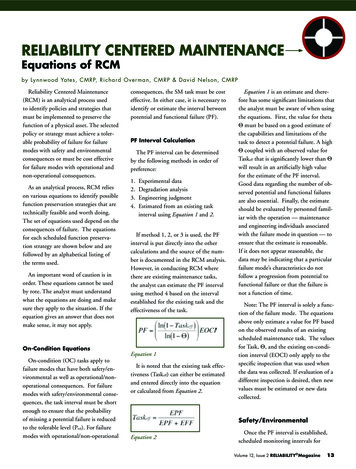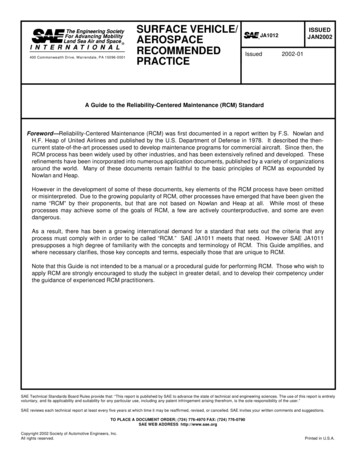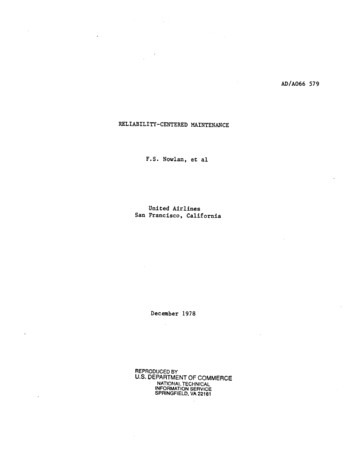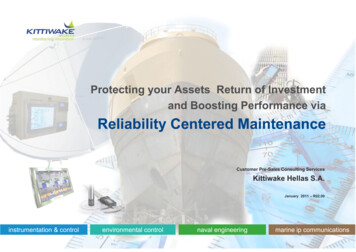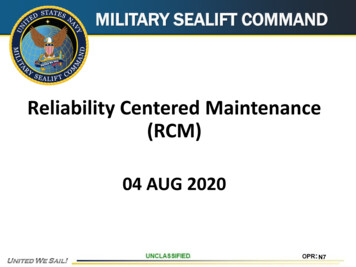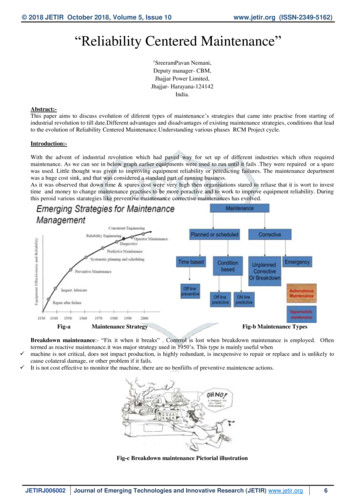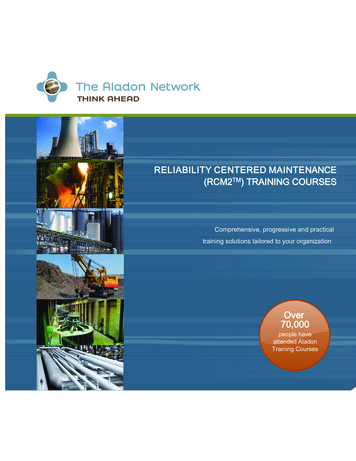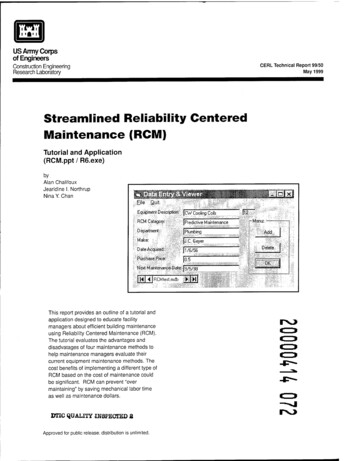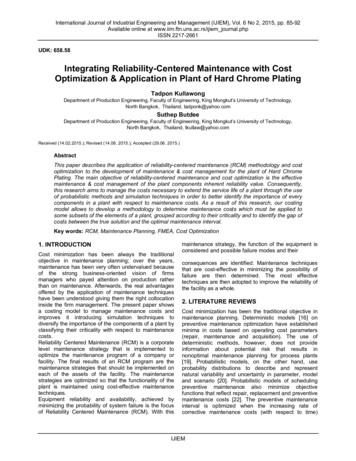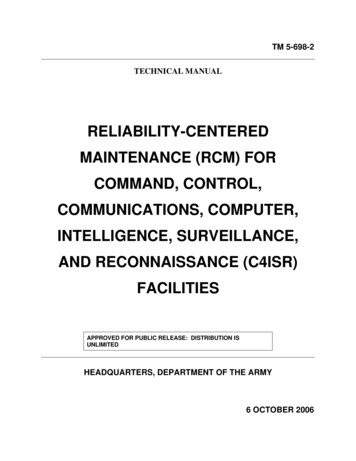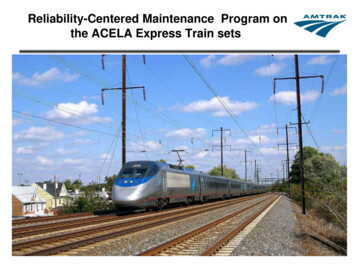
Transcription
Reliability-Centered Maintenance Program onthe ACELA Express Train sets
Amtrak ACELA Express Amtrak currently runs ACELA Express Servicefrom Washington, DC to New York City andBoston. There are currently 34 train assignments in thiscurrent time table representing the NortheastCorridor covering every hour from 5 am to 7 pm. The ACELA Fleet has 20 Train sets configuredwith two Power Cars and six Coach Cars each.
Acela Power Cars Continuous 4,600 kW/ 6,000 HP 4 asynchronous AC traction motors 3 GTO-Type inverters, 2 for propulsion and 1 forauxiliary power required by the power car and passengercars. Top operating speed of 150mph (165mph designed) The Main Transformer has two primary windingsconnected in parallel for operating overhead AC supplyof 12kV at 25Hz or 12.5kV at 60Hz and seriesconnection when the overhead input is 25kV at 60 Hz. Braking system incorporates blendedregenerative/rheostatic dynamic Braking
High Speed Trainset Tilting System Each Passenger Car is equipped with an activecomputer controlled and electro hydraulicallyactivated tilting system. Maintains low lateral acceleration throughcurves at high speed. The curve detection is sensed by the lead powercar triggering the tilt function. Amtrak currently operates at 7 inch cantdeficiency (it is designed and tested at 9 inchcant deficiency).
ACELA Passenger Demandfor 008Future?
ACELA Passenger Demandfor ServiceAmtrak developed Continuous Maintenanceprogram (CM) for Planned Maintenance(PM) to increase availability of equipment. PM requirements divided into manageablesegments performed during Service andInspection dwell time. Previous to CM two Trainsets wereshopped for PM
Amtrak and RCM: Background Amtrak established Condition-BasedMaintenance (CBM) as corporate policy inJuly 2006 Amtrak reviewed and validated all AcelaTrain set maintenance requirements usingReliability-Centered Maintenance (RCM),per 49 CFR Part 238 Appendix E. Acela Level I (Daily), Level II (92Day) andLevel III (Long Term) requirements werereviewed and completed in 2006.
d Maintenance (RCM) asused by Amtrak incorporates severaltechniques and tasks: Maintenance Effectiveness Review Root Cause Analysis Condition Based Monitoring
Maintenance Effectiveness Review(MER)
Maintenance EffectivenessReviewMER analysis identify the applicability andeffectiveness of maintenance tasks. Applicability criteria is the specific set ofconditions for a given task type that must be metto improve or maintain system or equipmentinherent reliability Effectiveness criterion judges whether a specifictask would be capable of reducing the failure forits failure consequence. Task periodicities are based on evidence ofneed and assessment of risks.
Maintenance EffectivenessReviewCross Functional Stakeholders Mechanics who perform the tasks Operational Management Representative Equipment Engineering Representative Operator or End User OEM Representative Facilitator
Maintenance EffectivenessReviewTask Type On Condition, renew life based on comparisonwith standard, initiating action upon reachingpotential failure point. Age Limit, renew life regardless of condition,taking action prior to “anticipated” failure point. Failure Finding, determine whether a hiddenfailure has occurred, initiating corrective actionwhen initial failure occurs.
Maintenance EffectivenessReviewFailure Consequences Safety, functional failure results inpossible loss of occupants or equipment Operational, functional failure results inindirect economic loss plus direct cost ofrepair Non-operational, functional failure resultsin direct cost of repair
MER ComponentAnalysis Spreadsheet1. ComponentInformation Part Number Description Car (PC/TC) Quantity3. Risk Assessment2. FunctionalDescription5. In-Service Monitoring Plan Current ITM and Monitoring Additional Diagnostic Capabilities Additional Test Procedures Probability of Failure(failure history: OEM andRev. Service) Severity of Failure(FMECA failure effects)4. Condition Baseline OEM Recommended Life Cycle Bench Test Results Teardown Inspection Results
Root Cause Analysis
Root Cause AnalysisAmtrak has incorporated a standard maintenancepractice on how a Root Cause Analysis sessionis performed. The method used is based onReliability Center Incorporated’s PROACTsystem. Preserving Event Data Ordering the Analysis Team Analyzing the Data Establishing Root Causes Communicating the Findings Tracking for Results
TILT SYSTEM RCA RESULTS Constant displacement pump and unloading circuitinstallation– Increased pump reliability and reduction in service delays– Improved onboard oil filtration, decreasing hydraulic oilcontamination and reduction in component wear– Reduction in necessary periodic external filtration to maintainstandard ISO level Minimum and centering pressure switch upgrade– Reduction of in service failures Tilting load locking valve replacement with dualpressure transducer– Allows for condition based monitoring and implementation ofcontinuous maintenance tasks– Reduction of in service failures Quick connect fitting upgrade– Reduced external hydraulic leakage– Reduction of in service failures
Acela Tilting Delay MinutesM inutes of DelayACELA Tilting Delay Minutes By MonthBased on Amtrak's ARROW 07
Acela Tilting System MDBFACELA Tilting System MDBFMaximum Likelihood Estimation (MLE)Series1Linear (Series1)M ean D istan ce B etw een F ailu ,75111,848 10,428 12,25110,000 y0June07MonthsJul7y0Aug07Sep07Oc7t0No70vD0ce7
Condition Based Monitoring
Condition-Based Monitoring Dynamic Monitoring detects potential failures that emitabnormal energy such as vibration or acoustical waves. Particle and Chemical Monitoring detects potentialfailures by analyzing discrete particles or traceablequantities of chemicals released in the component’soperational environment. Physical Monitoring detects potential failures byanalyzing changes in the physical structure such ascracks, wear or dimension. Temperature Monitoring detects potential failures bysensing temperature differentials in the component’soperational environment. Electrical Monitoring detects potential failures thatproduce changes in resistance, conductivity, dielectricstrength and potential.
Remote Condition Monitoring
Actual, En-route Notification ofReportable DC Ground Fault
Element of June 2007 Acela FleetHealth Analysis
Proposed Dynamic health display tobe located in Maintenance Facilities
Seventy-Two (72) Annulments Have BeenAvoided Since October 2006Cumulative Acela Annulments since January 2006250Acela annulmentstrend was 8 per month200150Savings 72Amtrak takes overAcela Maintenance10050New “RCM” Acela ITMActual annulmentsnow average 3 -0-0-0-0-0-0-0-0 p-0-0-0-0-0l-0 JuJaAJuJaFeMONFeMONASDASDMMActualFY06 Projected
Fewer Terminations70Cumulative Acela Terminations since January 20066050Acela terminationsFY06 trend lineSavings 94030Amtrak takes overAcela MaintenanceActual terminations trendinglower2010New “RCM” Acela ITMJ an-0 6Feb- 06Mar- 06Apr- 06May -06J un-0 6J ul-06Aug- 06Sep- 06Oct- 06Nov-06Dec-06J an-0 7Feb- 07Mar- 07Apr- 07May -07J un-0 7J ul-07Aug- 07Sep- 07Oct- 07Nov-07Dec-070CumulativeFY06 Projected
Reliability-Centered Maintenance Program onthe ACELA Express Train sets
Maintenance (CBM) as corporate policy in July 2006 Amtrak reviewed and validated all Acela Train set maintenance requirements using Reliability-Centered Maintenance (RCM), per 49 CFR Part 238 Appendix E. Acela Level I (Daily), Level II (92Day) and Level III (Lon
